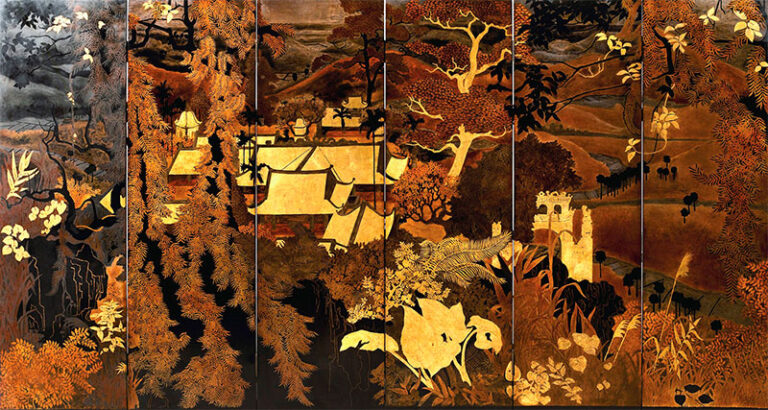
Contents
I. Modern Painting
What is Modern painting? What is different from previous painting trends?
The difference is in the concept of giftedness. Talent is a necessary element for an artist, but in Modern Painting, people assert that talent, one of the factors that help artists create attractive works, is unnecessary. The product of painting is not just beautiful things, not just to satisfy a taste; it also seeks sympathy and sharing. It must communicate a message with the formula:
Great work = Profoundness + complexity + originality.
This modern trend has entered the Vietnamese painting environment since the 1929 exhibition at the Indochina School of Fine Arts.
Eighty-five years ago, on October 7, 1924, in Hanoi, Governor-General of Indochina Martial Merlin signed a decree to establish the Indochina School of Fine Arts, with the French name École Superieure des Beaux-Arts de L’Indochine. The person in charge and principal is the French painter Victor Tardieu.
The school operated for 20 years (1925-1945) and awarded diplomas to 128 student artists, including bright stars of Vietnamese fine arts such as Nguyen Phan Chanh, Le Van De, To Ngoc Van, Le Pho, Nguyen Gia Tri, Bui Xuan Phai, etc.
The first historical exhibition in Vietnam opened at the Indochina School of Fine Arts, 102 Reinach Street, Hanoi, on Friday, November 15, 1929 (80 years ago), significantly impacting contemporary life and the public. Silk and lacquer paintings had yet to be born at that time. At that time, L’Avenir du Tonkin (The Future of Tonkin) solemnly ran the headline on cover 1: A new school of painting and sculpture, “Vietnam School.” In that newspaper, journalist Yvonne Schultz wrote: “This school of painting, one can now call the Vietnamese school, will enrich the Far East with works adapted to the sensibilities of Vietnamese people in the 20th century. Historically, the development process of Vietnamese oil painting is very different from that of India, China, and Japan. Vietnamese artists have adopted Western painting techniques, especially oil painting techniques, directly through French artists (Victor Tardieu and Joseph Inguimberty) as a universal means to build for themselves. We have the FIRST national, professional, authored painting, a scholarly painting in the spirit of the new era, while still ensuring it is deeply rooted in the source of traditional fine arts culture. ”.
A. First period (1925-1945)
During the Indochina period, Vietnamese oil painting had more or less its distinct nuances, with exceptional content, reflected in masterful works such as “Young Woman in Flowers” (Thieu Nu Ben Hoa Hue)” by To Ngoc Van, “Playing O An Quan” by Nguyen Phan Chanh, “North-South Spring Garden” (Vuon Xuan Bac Nam) by Nguyen Gia Tri, etc. Vietnamese artists have gone from Classicism to Realism and somewhat continued. Approaching Modern schools such as Impression…
B. The period from 1945 to 1975
The North entered a period of resistance, and Vietnamese oil painting transformed the achievements of the previous period into socialist trends. The remaining number migrated to the South, merging with Gia Dinh Cao Dang Fine Arts School, now Ho Chi Minh City University of Fine Arts, No. 5 Phan Dang Luu, Binh Thanh District, City. HCM.
During this period in the South, that is, old Saigon, famous artists from all over held exhibitions continuously at Ty Van Hoa (Tu Do Street), at the Vietnamese American Association, with ancient painters like Nguyen Gia Tri, Van Den, Nguyen Sien, Ta Ty, Hieu De, Nguyen Thanh Thu. In the 60s, another group of young artists in Saigon was established, including artists Nguyen Trung, Ho Thanh Duc, Be Ky, Ho Huu Thu, Trinh Cung, etc.
This was the heyday of the Modern schools: Impressionism, Cubism, Surrealism, Abstraction, etc. During this golden age, the public highly respected and loved artists, especially the upper class. Middle-class intellectuals, doctors, engineers, civil servants, professors, etc. After each month’s salary, they often set aside money to collect paintings and statues.
C. The period from 1975-1990
After the country’s unification, in that the whole country still lives in a centralized subsidized economy, Saigon-HCMC has a force of artists from very different training sources, from socialist countries. Capitalism, such as the Soviet Union, Czechoslovakia, Hungary, Poland, and China, and capitalist countries like France, America, Italy, England, and Japan…
The South, in particular, is continuously carrying out social reform and building a new society that still needs to be familiar to the people of Saigon and the local artists and writers. That’s why many people who held brushes at that time were re-educated or quit painting. The rest became timid in the face of changing social circumstances. During this time, there were almost no paintings and statues by individuals or private organizations, only general exhibitions organized by the City Fine Arts Association or the Vietnam Fine Arts Association for localities. Artists paint according to themes periodically every year or every five years.
II. Post-Modern Painting
Innovation period (1990-2009)
They started with the Vietnam-US cultural exchange following the war from both sides program of the Indochina Arts Partnership initiated by American painter David Thomas. American artists and artists from other countries come to Vietnam to exhibit. On the contrary, Vietnamese artists go to the US and advanced countries worldwide to show and exchange.
This period was when the market economy opened, Vietnam joined the WTO, and artists had access to a lot of information especially young artists had the opportunity to assert themselves through Post-Modern schools such as Pop Art. , Body Art, Performance, Installation etc… All three regions of the country: Hue, Saigon, Hanoi, exploding exhibitions of paintings, statues, individuals, groups, clubs, Newspaper offices, Pagodas, Churches, Fine Arts Associations everywhere… Galleries are springing up like mushrooms, but mainly to trade paintings and copies of famous foreign authors. Creative paintings receive little response from the public, especially paintings based on religious themes.
Thus, since 1990, in the Vietnamese painting environment, the Post-Modern school has appeared (Pop Art, Body Art, Performance, Installation, etc.) But what is the Post-Modern school? What is different from previous trends in Modern Painting?
Modern science and technology today push people to brilliant heights. But successful people in this era find it harder to open up than before. They have gone through painful times and no longer have faith in contemporary life and society, so they have become wary. That may be why the beauty of painting is more difficult to absorb.
It was that newly wealthy and successful class that broke the world of perception and emotion into many aspects and times and then rearranged it according to the individual’s senses with the formula:
Great work = Profundity + freedom + individuality.
Thus, Modern Painting and Post-Modern Painting are similar in that they both emphasize profundity and are different in that:
- Modern painting highlights complexity and primitiveness.
- Post-modern painting places particular emphasis on freedom and individuality.
Another unique feature of Post-Modern Painting is that the viewer “co-creates” with the author. When looking at the painting at different times, they discover new angles and meanings, giving the painting a new name. The painting is an open work…
III. Identify Vietnamese painting
The world’s art industry has never faced such significant challenges as it does today because people have lost faith in life’s direction and quickly become corrupt. Since then, thinking about Beauty has given rise to many new concepts, often contrary to traditional aesthetics. But by nature, human abilities are not enough to recognize value. The distance between languages and ideas between generations is becoming increasingly distant, making connection, sharing, and love difficult. Young people in developing countries need clarification and direction.
Currently, the darkness of post-modernism is increasingly covering the world. Unlike science and technology, where there is always a common denominator, in the painting environment, no one is the same; each person has their style. Each person’s Modernity or Post-Modernity comes from deep within, and all express a certain aesthetic sense of Beauty. In addition, today’s education is intuitive: doing immediately, combined with information disturbance from the internet, is also a part that hinders the absorption of the old style of the Modern school.
Postmodernism has disrupted the cognitive and emotional world in many ways, leading to two different results: positive and negative:
- On the negative side, artists expect a space to satisfy the ego rather than looking for new, more perfect values. Because they come from a background of rebellion and confusion, which results in them not knowing who they are! “Who am I, who am I, that I am still on this earth? Who am I to love this life so much?” (Trinh Cong Son song)
- On the positive side, some artists put their faith in God’s love; at that time, their minds had peace. At first, their cognitive world was broken, but when they rearranged it, they could lead their confused ego to follow the voice of love.
The truth is that when progressing on the path of fine art, the artist gradually shakes off his reservations, inhibitions, and complexes to express himself and become himself while painting. The more they know, understand, and interact, the more they sympathize with others, and the more they grow to know how to mix colors in the way of “taking, giving thanks, breaking, and giving”. At that time, they did not need to try to prove that they were following the Modern or Post-Modern style, did not need to push their personality to the point of being different, just let it “come naturally.”
IV. Vietnamese painting through materials
As one of the oldest traditional art forms, painting accompanies the development of culture and society. Around 30,000 to 10,000 BC, paintings appeared with human ancestors, and simple images on cliffs were the first steps of this brilliant art form. The attractive thing about this painting is enjoying a work from many different aspects. And one of those factors is the material the artist uses. A painting can be created from oil, lacquer, watercolor, gouache, pastel, etc. Let’s explore painting through the classification of materials.
Oil painting
Before there was oil paint, artists often used tempera material. The flexible nature of tempera is one factor that shapes oil paint today. Even when oil paint was introduced, the tempera technique was preserved. Medieval painters often painted the lower layers of oil paintings with tempera, then applied layers of liquid oil paint on top. Scumbling style. Only during the time of the painter Van Eyck brothers (about 1390-1441) was the oil painting technique perfected and developed. The oil paint colors of this period were more transparent and brighter, had a beautiful shine, were waterproof, durable, and could withstand the test of time. Since then, oil paint has been widely used and is commonly used in most countries worldwide. Perfecting oil painting is a major technical revolution, transforming and enhancing the art of painting. The better the artist understands the technique, the better the quality of the work and the longer it can be preserved.
Particularly in Vietnam, oil painting techniques were introduced to our country when the French colonialists opened the Indochina College of Fine Arts in 1925, under the training of Victor Tardieu and Joseph Inguimberty, a generation of famous painters One another was born such as To Ngoc Van, Le Pho, Nguyen Tu Nghiem, Bui Xuan Phai, etc. After nearly 100 years, although oil painting techniques have yet to have any significant leaps or developments, young painters are trying to inherit and develop this technique. A typical example is the book “Oil Painting Techniques” by artist and scientific researcher Nguyen Dinh Dang, published in 2009 by Dong-A Publishing House. His book is a significant contribution to Vietnamese painting…
Lacquer
Lacquer techniques first appeared in Japan and China but are still limited, particularly in processing handicrafts. It was only when it was introduced to Vietnam that lacquer material was introduced into painting. They are becoming one of the materials used in creating art. The grinding technique is one of the unique features of Vietnamese lacquer art. Indochina College of Fine Arts artists worked together to perfect and develop this technique. Lacquer paintings use traditional lacquer and cockroach wing paint as adhesives, lipstick, silver plated, gold plated, pearl shells, etc., painted on a black background. Paintings can be painted and polished many times until the artist desires, from which the terms “lacquer” or “lacquer painting” are widely used. Accompanying the history of Vietnamese lacquer paintings are names such as Nguyen Gia Tri, Nguyen Duc Nung, Hoang Tich Chu, etc. Creating a lacquerwork can take artists months. A well-preserved lacquer painting can last from 400 to 500 years.
Nowadays, artists prefer to use Japanese paint materials when painting lacquer paintings. Because tar paint can cause side effects of skin erosion, the use of tar paint depends a lot on weather conditions. When the weather is humid, the paint dries faster, whereas when the weather is dry, the paint takes a long time to dry. Meanwhile, Japanese paint dries quickly and is easier to control. However, it is impossible to create the same depth or shine as Vietnamese paint when using Japanese paint. Therefore, to make paintings glossy, people often use a layer of transparent paint (cockroach wing paint) to cover the outside of the painting. But no matter what, lacquerworks are still more popular because of the meticulousness involved in creating them.
Watercolor
Watercolor became one of the painting materials during the Renaissance. The German Renaissance painter Albrecht Dürer (1471–1528) produced several watercolor paintings of trees, wildlife, and landscapes, so he is considered one of the pioneers in using this technique—watercolor painting. The exciting thing is that watercolor not only acts as a material that creates artistic value but is also widely used for scientific research, such as real-life illustration—objects, map drawings, archaeological drawings, design drawings, etc. Unlike the long-drying plasticity of oil paint or the elaborate lacquer polishing, watercolor is gentle, pure, and Rapid drying. Watercolor is formed when pigments (usually in powder form) are dissolved in water to create a colorful solution and are often drawn on standard materials such as paper, Do paper, silk, etc. In China, ink painting or calligraphy painted and written with ink is also one of the types of watercolor painting.
Although there is also the influence of Chinese culture, Vietnamese painting also undergoes the training of French art, and the watercolor paintings of Vietnamese artists all have their unique properties. Mai Trung Thu’s silk paintings themselves are a typical example of combining the brilliant contrast of Western colors with the gentle, liberal designs of the East. Artists commonly used Russian watercolors in Vietnam from 1960 until now, branded Leningrad. According to artist Phan Cam Thuong, during the war, it was viral for Vietnamese artists to use watercolor to create realistic sketches and paintings. Many artists complete their drawings right on the spot, surpassing the meaning of a conventional note. That freedom in creativity has developed a unique watercolor painting technique. Nowadays, artists stop using watercolor alone and combine watercolor with other methods such as wax, pencil, natural color, powder color, etc. Painter Phan Cam Thuong is also one of the significant contributors to the development of Vietnamese painting. The artist himself has seriously researched the technique of painting natural colors on silk and on Do paper for many years and has concluded for himself the essence of the method of mixing color and dyeing silk, making silk paintings, and Do paper paintings have a long life. No worse than lacquer or oil paintings.
Acrylic paint
Acrylic paint is a fast-drying paint made with pigments in an acrylic polymer emulsion. Most acrylic paints are water-based but become water-resistant when dry. Depending on how much the paint is diluted with water or modified with gels, mediums, or acrylic pastes, the finished acrylic painting may resemble watercolor, gouache, or oil painting or have distinct characteristics. It can be achieved by other means. Between 1946 and 1949, Leonard Bocour and Sam Golden invented solution acrylic paint under the Magna paint brand. These are paints derived from mineral spirits and were marketed in the 1950s. With such a young history, acrylic paint is only sometimes a popular material for painters. Academically trained artists, but it is trendy among freelance artists, artists practicing experimental art, or painters with multi-media works. Acrylic can bond to many surfaces, such as paper, fabric, mirrors, etc. They can also be used to build up thick layers of paint to create gels and pastes or paintings with relief properties. Acrylic paint is synthetic paint that, while flexible, lasts only 15 to 20 years. However, acrylic paint is still a popular material in applied arts. Many famous painters and artists use this material in their works, such as Andy Warhol, Robert Motherwell, and Kenneth Noland, …
Multi-material
The painting focuses on creating space on a flat surface. No longer tied to traditional materials such as canvas, wood, and silk, along with the artist’s creativity, the surfaces used have gradually become more diverse over time. Today, we can even admire works on walls, aluminum panels, and mirrors… The appearance of multi-material paintings is a step forward in painting. A multi-media painting is a painting that combines different materials and painting methods instead of just one medium. Any material can be used, including collage items such as pages from magazines, newspapers, photos, fabric, packaging, or a piece of mixed material that can be as “simple” as using two mediums, such as acrylic paint with pastels on canvas. Multi-material painting is not a phenomenon of the 20th century but has appeared in previous centuries. Painter Leonardo da Vinci often added gold leaf to his church paintings, William Blake used watercolor washes in his prints, and Edgar Degas combined pastels with charcoal and ink.
V. Masterpieces of Vietnamese painting are national treasures
Two young women and a baby
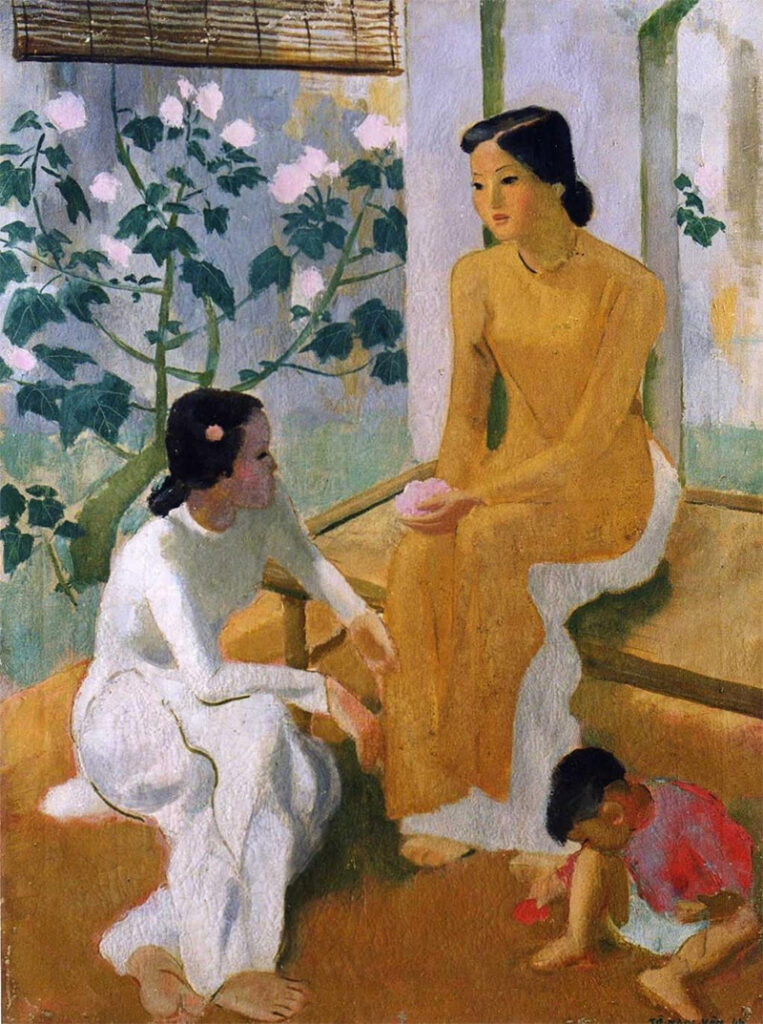
Dimensions: 102cm x 71.8cm
The painting depicts a peaceful space with two women wearing flowing dresses sitting and confiding on the porch next to a boy playing. The three characters are arranged in a triangular shape, creating a state of tranquility, balance, and tranquility. Along with the warm yellow color surrounding the author, he has created a wonderful harmony between the natural scenery and the soft expressions of two women in elegant, traditional Ao dai.
Unique features of the painting: The triangular composition in the vertical frame of the three characters is a very classic composition of Western painting art. However, the peaceful space with the bamboo bed, bamboo curtain, and white flower plant, along with the ao dai costumes of the female characters, shows a very Eastern scene and a very Vietnamese one in the early twentieth century. The painting has created a thrilling combination of Eastern soul and contemporary Western learning style of illustration.
The work marks a period of Vietnamese fine art in the first half of the twentieth century, bearing the unique style of master painter To Ngoc Van of Modern Vietnamese fine art. The work is an inheritance of Western visual style but is blended in a clear Eastern spirit. The work exudes sophistication with oil paint in the expressive images of Vietnamese women in the early twentieth century.
The work reflects the characteristics of Vietnamese social culture before the August Revolution in the eyes of intellectuals at that time. This is one of the pinnacle works of artist To Ngoc Van, creating a strong influence on subsequent generations. The painting is one of the highlights contributing to the study of elements and values of East-West cultural exchange on the level of visual arts.
Painter To Ngoc Van (1906-1954), known by the pen names To Tu and Ai My, is from Van Giang, Hung Yen, and graduated from the Indochina College of Fine Arts in 1931. He is considered one of four artists. The great master of modern Vietnamese art. He received the Ho Chi Minh Prize for literature and art in fine arts in 1996.
Thuy
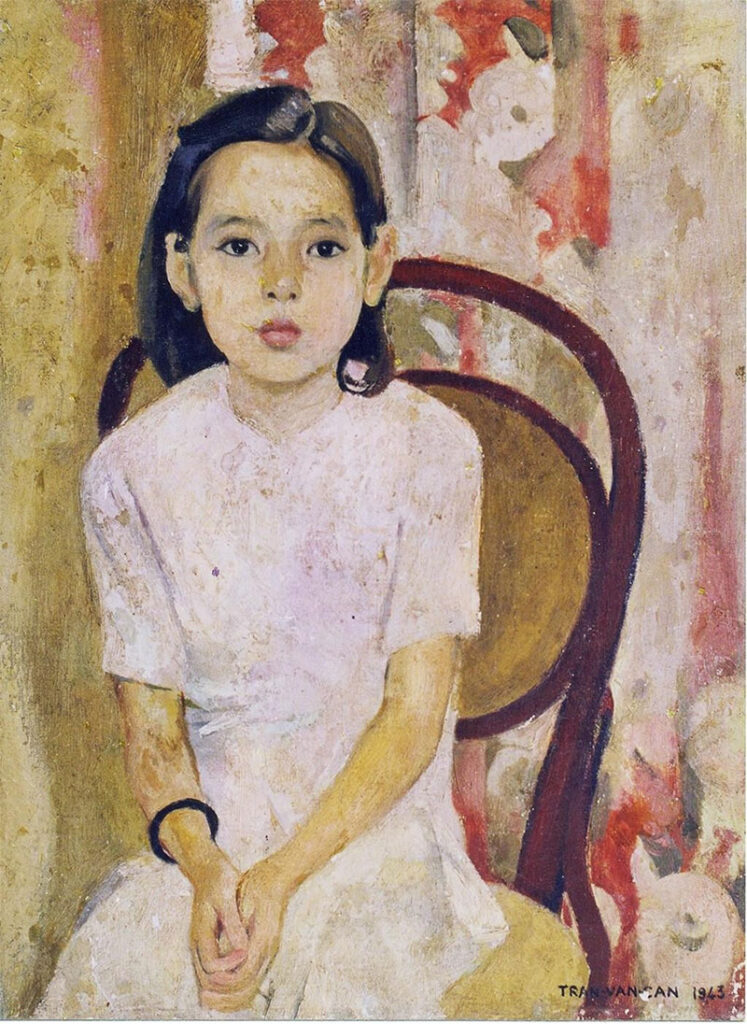
Size 60cm x 45cm
The painting depicts a bust portrait of a real-life character, little Thuy, sitting on a rattan chair. The author describes the little girl as having a romantic, delicate, pure spirit with bright, warm colors and gentle curves.
The unique feature of the painting is that the author used a typical European-style composition of the early 20th century to express the mood of a Vietnamese child. The painting is a smooth combination of Eastern soul and illustration style learned from contemporary Western art.
The work marks a historical period of modern Vietnamese fine art in the first half of the twentieth century..
The work bears the unique style of artist Tran Van Can, a master of modern Vietnamese fine arts. The work is an inheritance of Western visual style but is blended in a clear Eastern spirit. With oil paint, the work represents the art of portraiture, as well as the genre of Vietnamese portrait painting in the early twentieth century.
This is one of the pinnacle works of artist Tran Van Can, creating a strong influence on subsequent generations. Through Thuy’s portrait, the work contributes to reflecting the image of Vietnamese society before the August Revolution. The painting is a typical contribution to studying elements and values of East-West cultural exchange on the level of visual arts.
Painter Tran Van Can (1906-1954), born in Kien An, Hai Phong, graduated from Indochina College of Fine Arts in 1936. He is considered one of the four significant figures of modern Vietnamese art. He received the Ho Chi Minh Prize for Literature and Art in Fine Arts in 1996. The painting was repaired in 2005 by an Australian expert.
Spring garden between North and South

Size: 540cm x 200cm.
The work’s composition spanned 20 years, starting in 1969 and completed in 1989. The painting depicts the spring atmosphere and images of young women from the Central, Southern, and Northern regions in traditional costumes. Go to the spring festival, temples, and surrounding trees.
The work was composed when the country was still engulfed in the flames of war. It is like a prayer for unity and happiness for the homeland. At the same time, the work is also a synthesis of all achievements in half a century of creative exploration of lacquer art: it is the work with the most extended dedication, the most application of artistic conclusions, and the most stimulating: the enormous scale and the last creative work of artist Nguyen Gia Tri’s life. In 1991, the work was purchased by the People’s Committee of Ho Chi Minh City for 100,000 USD and donated to the Ho Chi Minh City Museum of Fine Arts. Recently, the museum’s preventive cleaning and preservation caused up to 30% damage to the work. The incident made art lovers and the public sad.
Artist Nguyen Gia Tri graduated from Indochina College of Fine Arts (1936). He is a master painter, a pioneer in creating new trends in lacquer art, exploring and innovating to create a new color palette and bring Vietnamese lacquer to its peak with the combination of traditional Asian cultural elements of Vietnamese people on lacquer material and assembly methods. Western academic drawing on graphics. In 1989, artist Nguyen Gia Tri was officially recognized by the Ministry of Culture and Information as one of the contemporary artists who contributed to building modern Vietnamese visual arts.
Girl in the Garden and Landscape

Dimension: 159cm x 400cm
This is another work by Nguyen Gia Tri recognized as a National Treasure as a two-sided screen: Young Girl in the Garden and Landscape. The work consists of 8 panels assembled into a rectangular screen measuring 159cm x 400cm. The first side of the screen shows a painting of a girl in the garden of noble and elegant quality. On a gorgeous yellow background are images of graceful young women in flowing Ao Dai in a romantic landscape of flowers, trees, and plants. There are several bullet holes on the surface of the painting, which have now been patched.
The second side of the screen is a Landscape painting depicting trees along the mosquito net in a Northern rural garden. The shimmering patches of eggshells, the red lipstick, the brilliance of gold… make the clusters along the mosquito net stand out. The screen is currently on display at the Vietnam Fine Arts Museum.
Party admission at Dien Bien Phu
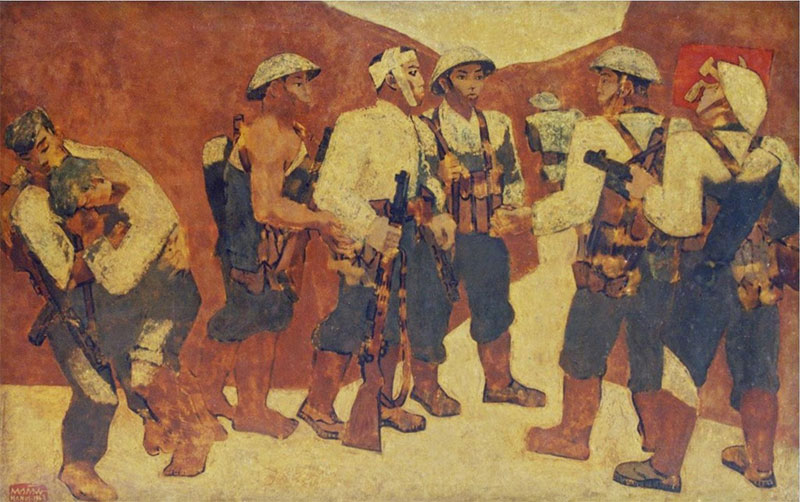
Dimensions: 112.3 cm x 180cm
The painting is a reconstruction of the heroic moment of Dien Bien soldiers on the battlefield with three groups of leading and supporting characters. The central group of characters includes three soldiers, one with a bandage on his head and a gun in his hand. This group of three is closely linked to the two other soldiers on the right side of the painting by a determined handshake. The entire scene of the party admission ceremony took place quickly in the space of the trenches. In the left corner is a soldier helping a wounded comrade, showing the fragile boundary between life and death. But in the background is another soldier rushing into battle as if that loss was the driving force, emphasizing the urgent context of the war. The painting can be considered an epic poem of the nation during the resistance war against the French, an image symbolizing the noble and fierce revolutionary spirit.
Nguyen Sang portrayed the images of Dien Bien soldiers in a simple, strong graphic style. The colors in the painting are simple, mainly in the traditional Chinese paint color system, such as red, gold, and silver. The particular painting has some new colors, such as blue and green, that were used successfully, marking an important milestone in the history of Vietnamese lacquer painting art.
The work realistically captures the image of a party admission in Dien Bien Phu, reflecting the heroic and fierce spirit of the nation’s historic war – the resistance war against the French. The painting plays an integral part in researching the historical values that led to the famous victory of the Dien Bien Phu campaign.
The typical style of a master painter of Vietnamese fine arts is an inheritance of the visual style of Western art with robust, realistic methods imbued with Vietnamese spirit and color. The work is a fundamental testament to Vietnamese Lacquer art’s diverse expressive capabilities and traditional fine arts’s decorative figurative style. The work has created substantial impacts on society, such as promoting the spirit of the army and people during the resistance war against the US – the time the painting was created, influencing generations of artists after Nguyen Sang’s reign with the spirit of being an epic poem about patriotism and the revolutionary spirit of the Vietnamese people.
Painter Nguyen Sang (1923 – 1988), from My Tho, Tien Giang, graduated from Indochina College of Fine Arts in 1943. He is considered one of four outstanding figures in the quartet of modern art. Great Vietnam. He received the Ho Chi Minh Prize for Literature and Art in Fine Arts 1996.
Uncle Ho was in the Viet Bac war zone
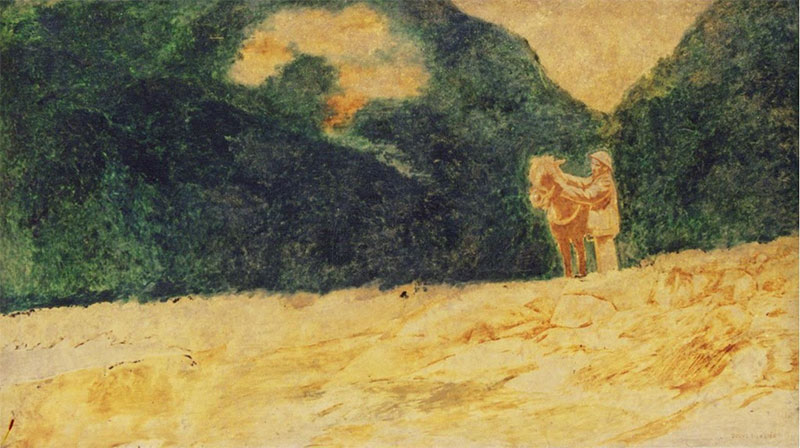
Dimensions 99.8cm x 180cm
Painting of Uncle Ho and his horse preparing to cross the stream. He was dressed in a simple brown shirt and cloth bag, calmly preparing to cross the flood. The person and horse merge into a small block in the suitable 1/3 of the picture. The vast space of mountains, forests, sky, and water is represented by two primary colors, yellow and green as if dividing the painting. People are highly leisurely and at ease if the hills and forests seem restless and the water flows. People do not have to brace themselves in front of nature but calmly pat the horse. The work is currently displayed at the Vietnam Fine Arts Museum.
Artist Duong Bich Lien (1924 – 1988), born in Hanoi. He was one of the last students of the Indochina College of Fine Arts, Department of Painting, class XVIII (1944-1945), and was the first revolutionary artist in the Vietnamese painting industry. Duong Bich Lien is a talented artist who is very passionate about drawing. He did not leave his easel even during the fiercest days of the American enemy’s destructive war. Duong Bich Lien’s painting career is a valuable asset of Vietnam’s Fine Arts treasury.
Giong
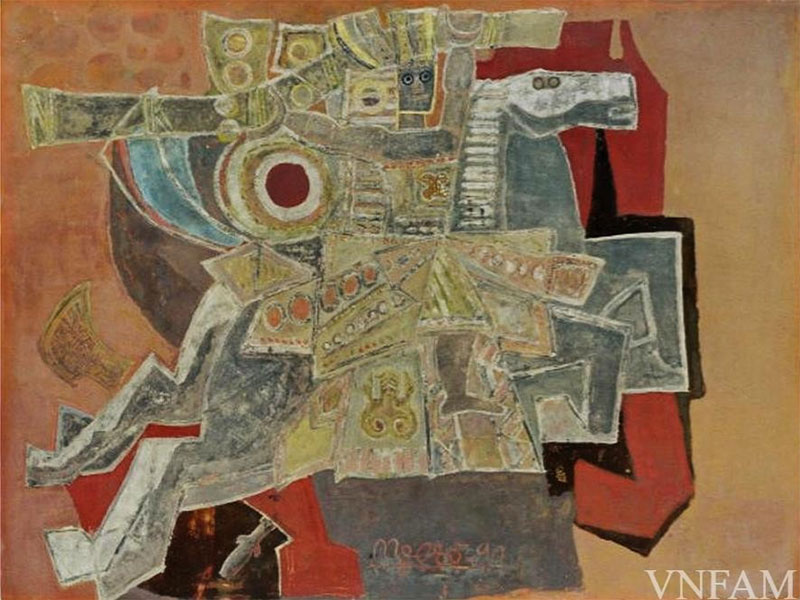
Dimensions 90cm x 120.3cm.
The work depicts Saint Giong as a symbol of the nation’s desire for independence, freedom, and resilience. Using the visual language of cubist art, the author exploited ethnic motifs on Dong Son bronze drums and Ly Tran ceramic patterns, creating a unique identity. Nguyen Tu Nghiem’s works are precise, technically skilled, and rich in national character. He once said: “I am not attached to any foreign art; I just look for the nation and see that there is humanity and modernity in the nation.” The painting is on display at the Vietnam Fine Arts Museum.
Painter Nguyen Tu Nghiem (1918 – 2016) in Nam Dan, Nghe An. At 19, he entered the Indochina College of Fine Arts. At the age of 22, Nguyen Tu Nghiem created a buzz when his work won first prize at Salon Unique’s exhibition with the oil painting Guardian of the Temple of Literature.
Experts solemnly classify the artist as one of the “four pillars” of the second generation of modern Vietnamese fine arts, including the famous painter “Nghiem – Lien – Sang – Phai, ” and the last person in the series to die in this quartet. Together with the first group of “four pillars” (Nguyen Gia Tri – To Ngoc Van – Nguyen Tuong Lan – Tran Van Can), they are the faces that represent the achievements, as well as the typical styles of Vietnamese painting. in the period from the early 20th century to the present.